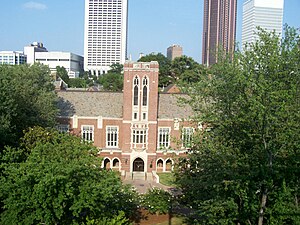
Wesleyan College is a private, liberal arts women's college in Macon, Georgia, United States. Founded in 1836, Wesleyan was the first college in the world chartered to grant degrees to women.

Home Park is a neighborhood of Atlanta in Georgia, US. It is bordered on the south by Georgia Tech, on the west by the railroad yards adjacent to Marietta Street and Brady Avenue, on the north by 16th Street at Atlantic Station, and on the east by Techwood Drive at I-75/85.
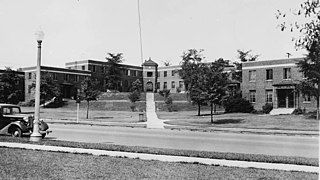
Techwood Homes was an early public housing project in the Atlanta, Georgia in the United States, opened just before the First Houses. The whites-only Techwood Homes replaced an integrated settlement of low-income people known as Tanyard Bottom or Tech Flats. It was completed on August 15, 1936, but was dedicated on November 29 of the previous year by U.S. President Franklin D. Roosevelt. The new whites-only apartments included bathtubs and electric ranges in each unit, 189 of which had garages. Central laundry facilities, a kindergarten and a library were also provided. Techwood Homes was demolished in advance of the 1996 Olympics and is now Centennial Place Apartments.

William Anderson Alexander was an American football player and coach. He served as the head football coach at the Georgia Institute of Technology from 1920 to 1944, compiling a record of 134–95–15. Alexander has the second most victories of any Tech football coach. Alexander's 1928 Georgia Tech Yellow Jackets have been recognized as national champions by a number of selectors. Alexander was the first college football coach to place his teams in the four major post-season bowl games of the time: Sugar, Cotton, Orange and Rose. His teams won three of the four bowls. The 1929 Rose Bowl win, which earned his team the national championship, is the most celebrated because of the wrong-way run by California's Roy Riegels. Alexander was also the head basketball coach at Georgia Tech for four seasons from 1919 to 1924. He was inducted into the College Football Hall of Fame as a coach in 1951.

Junior's Grill was a restaurant in Atlanta, Georgia, in the United States. It was located on the Georgia Tech campus in the Bradley Building near Tech Tower. It was a family business owned by Tommy Klemis. The restaurant served breakfast, lunch and dinner Monday through Thursday, and was famous among students for its French toast and battered chicken fingers. It closed on April 21, 2011, due to declining business.

Buzz is the current official mascot of the Georgia Institute of Technology. Buzz is usually represented as a stylized yellowjacket with yellow-and-black fur, white wings, a yellow head, and antennae. Buzz is almost never drawn with six legs, but rather with arms, legs, hands and feet, like a human. Invented in 1972 and restyled in 1979, Buzz reflects the tradition of referring to Georgia Tech students as "Yellow Jackets." Buzz is also one of Georgia Tech's emblems and trademarks, one that they defended in a 1998 legal conflict with the Salt Lake Buzz.
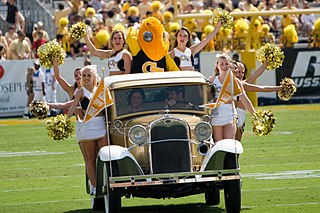
The Ramblin' Wreck from Georgia Tech is the 1930 Ford Model A Sport coupe that serves as the official mascot of the student body at the Georgia Institute of Technology. The Wreck is present at all major sporting events and student body functions. Its most noticeable role is leading the football team into Bobby Dodd Stadium at Historic Grant Field, a duty which the Wreck has performed since 1961. The Ramblin' Wreck is mechanically and financially maintained on campus by students in Ramblin' Reck Club.
The main campus of Virginia Tech is located in Blacksburg, Virginia; the central campus is roughly bordered by Prices Fork Road to the northwest, Plantation Road to the west, Main Street to the east, and U.S. Route 460 bypass to the south, although it also has several thousand acres beyond the central campus. The Virginia Tech campus consists of 130 buildings on approximately 2,600 acres (11 km2). It was the site of the Draper's Meadow massacre in 1755 during the French and Indian War.

Housing at the Massachusetts Institute of Technology (MIT) consists of eleven undergraduate dormitories and nine graduate dorms. All undergraduate students are required to live in an MIT residence during their first year of study. Undergraduate dorms are usually divided into suites or floors, and usually have Graduate Resident Assistants (GRA), graduate students living among the undergraduates who help support student morale and social activities. Many MIT undergraduate dorms are known for their distinctive student cultures and traditions.

The Georgia Tech Yellow Jackets football program represents the Georgia Institute of Technology in the NCAA Division 1 Collegiate Competitors in the sport of American football. The Yellow Jackets college football team competes in the Football Bowl Subdivision (FBS) of the National Collegiate Athletic Association (NCAA) and the Coastal Division of the Atlantic Coast Conference (ACC). Georgia Tech has fielded a football team since 1892 and, as of 2020, has an all-time record of 754-538-43 through the 2022 season. The Yellow Jackets play in Bobby Dodd Stadium at Historic Grant Field in Atlanta, Georgia, holding a stadium max capacity of 55,000.
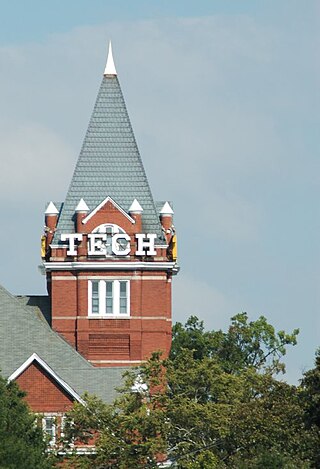
The Lettie Pate Whitehead Evans Administration Building, commonly known as Tech Tower, is a historic building and focal point of the central campus of the Georgia Institute of Technology in Atlanta, Georgia, United States.

Numerous Georgia Tech legends and traditions have been established since the school's opening in 1888, some of which have persisted for decades. Over time, the school has grown from a trade school into a large research university, and the traditions reflect that heritage. One of the cherished holdovers from Tech's early years, a steam whistle blows every weekday at various times to mark the changing of classes. It's for this reason that the faculty newspaper is named The Whistle.
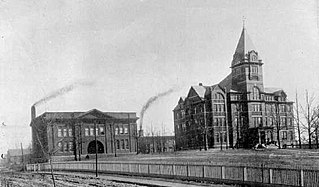
The history of the Georgia Institute of Technology can be traced back to Reconstruction-era plans to develop the industrial base of the Southern United States. Founded on October 13, 1885, in Atlanta as the Georgia School of Technology, the university opened in 1888 after the construction of Tech Tower and a shop building and only offered one degree in mechanical engineering. By 1901, degrees in electrical, civil, textile, and chemical engineering were also offered. In 1948, the name was changed to the Georgia Institute of Technology to reflect its evolution from an engineering school to a full technical institute and research university.

Marion Luther Brittain Sr. was an American academic administrator and longest serving President of the Georgia Institute of Technology from 1922 to 1944. Brittain was born in Georgia and, aside from a brief stint at the University of Chicago for graduate school, spent most of his life serving the educational community there. After receiving a Bachelor of Arts degree from Emory College in 1886, Brittain worked his way up the ranks from principal of an Atlanta high school to superintendent of education for the entire state of Georgia.

Kennesaw State University (KSU) is a public research university in the state of Georgia with two campuses in the Atlanta metropolitan area, one in Kennesaw and the other in Marietta on a combined 581 acres (235 ha) of land. The school was founded in 1963 by the Georgia Board of Regents using local bonds and a federal space-grant during a time of major Georgia economic expansion after World War II. KSU also holds classes at the Cobb Galleria Centre, Dalton State College, and in Paulding County (Dallas). The total enrollment exceeds 45,000 students making KSU the third-largest university by enrollment in Georgia.

The Georgia Institute of Technology is a public research university and institute of technology in Atlanta, Georgia. Established in 1885, it is part of the University System of Georgia and has satellite campuses in Savannah, Georgia; Metz, France; Shenzhen, China; and Singapore.
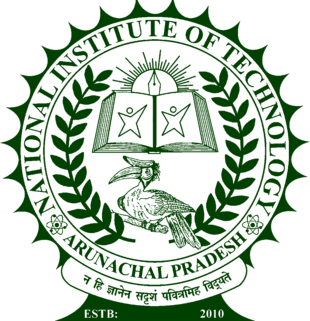
National Institute of Technology Arunachal Pradesh is a public technical and research institute located at Jote near Itanagar, the capital of Arunachal Pradesh. NIT Arunachal Pradesh is one of the 31 National Institutes of Technology in India and is recognized as an Institute of National Importance. NIT Arunachal Pradesh started its functioning from 2010 in a temporary campus in Yupia, Arunachal Pradesh. The institute presently functions from its permanent Campus at Jote, Papum Pare district, Arunachal Pradesh.

The main campus of the Georgia Institute of Technology occupies part of Midtown Atlanta, primarily bordered by 10th Street to the north, North Avenue to the south, and, with the exception of Tech Square, the Downtown Connector to the East, placing it well in sight of the Atlanta skyline. In 1996, the campus was the site of the athletes' village and a venue for a number of athletic events for the 1996 Summer Olympics. The construction of the Olympic Village, along with subsequent gentrification of the surrounding areas, significantly changed the campus.
